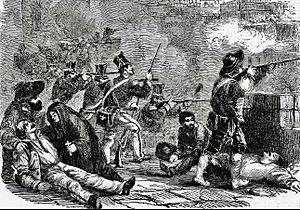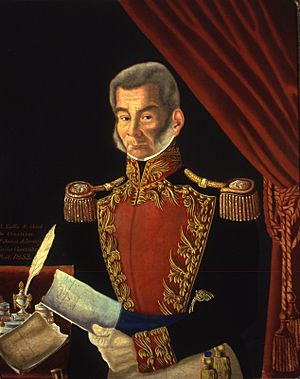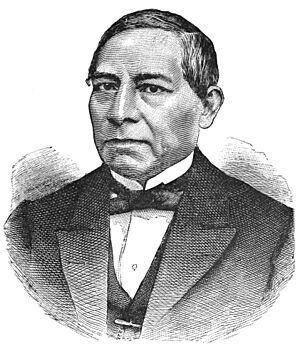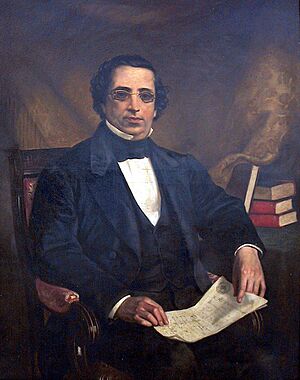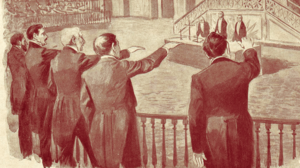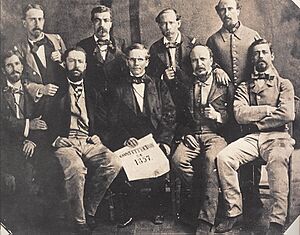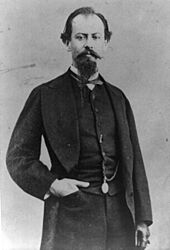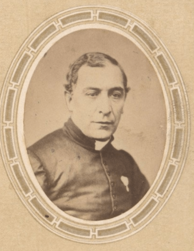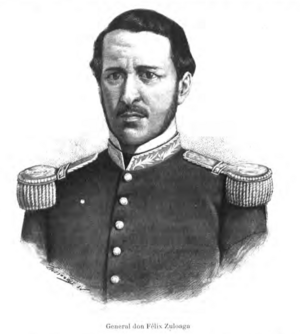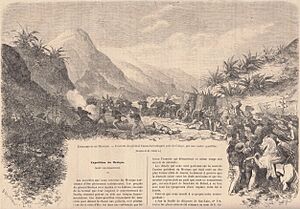Ignacio Comonfort facts for kids
Quick facts for kids
The Most Excellent
Ignacio Comonfort
|
|
|---|---|
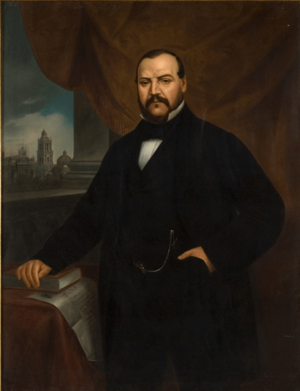
Portrait made by José Carrillo in 1855, oil on canvas, Museo de Historia Mexicana.
|
|
| 25th President of Mexico | |
| In office 11 December 1855 – 21 January 1858 |
|
| Preceded by | Juan Álvarez |
| Succeeded by | Benito Juárez |
| Secretary of War and Navy of Mexico | |
| In office 10 October 1854 – 17 December 1857 |
|
| President | Juan Álvarez |
| Preceded by | Manuel de Sandoval |
| Succeeded by | Manuel María de Sandoval |
| In office 19 August 1861 – 13 November 1862 |
|
| President | Benito Juárez |
| Preceded by | Felipe Berriozábal |
| Succeeded by | Juan Suárez y Navarro |
| Governor of Tamaulipas | |
| In office 16 March 1861 – 9 August 1862 |
|
| Preceded by | Jesús de la Serna |
| Succeeded by | Albino López |
| Governor of Jalisco | |
| In office 22 September 1854 – 30 August 1855 |
|
| Preceded by | Manuel Gamboa |
| Succeeded by | Santos Degollado |
| Personal details | |
| Born | 12 March 1812 Amozoc de Mota, Puebla |
| Died | 13 November 1863 (aged 51) Chamacueros, Guanajuato, México (now Municipio de Comonfort) |
| Nationality | Mexican |
| Political party | Liberal Party |
Ignacio Comonfort (born March 12, 1812 – died November 13, 1863) was a Mexican soldier and politician. He became the President of Mexico during a very important time called La Reforma (The Reform).
Comonfort was a key leader in the liberal movement. This group wanted to overthrow the powerful ruler Santa Anna. They succeeded in 1855 with a plan called the Plan of Ayutla. After Santa Anna was removed, Comonfort served in the government of the new president, Juan Álvarez.
Comonfort was known as a "moderate liberal." This meant he supported new ideas but wanted to make changes slowly. He became president when Álvarez stepped down. During his time as president, the important Constitution of 1857 was written. This new constitution included many changes from the Liberal Reform laws.
However, the constitution caused a lot of disagreement. It had strong rules that limited the power and wealth of the Catholic Church. For example, the Lerdo law made the Church sell its properties. This law also forced Native American communities to sell their shared lands. Many people, especially conservatives, were against these changes.
The government also made all public workers promise to support the new constitution. This was a big problem for many Catholics, who had to choose between their jobs and their faith. Comonfort thought some of these rules were too extreme and might lead to fighting. He also felt the constitution made the president's power too weak.
To try and find a solution, Comonfort joined a plan called the Plan of Tacubaya in December 1857. This plan canceled the new constitution. Congress was closed, and Comonfort stayed as president. But his liberal friends felt betrayed and left him. Comonfort then changed his mind and resigned. Benito Juárez, who was the head of the Supreme Court, became president.
A bloody Reform War (a civil war) broke out, which the conservatives lost in 1861. Comonfort went into exile, meaning he left the country. He returned in 1862 to fight against the French invasion of Mexico. Sadly, Comonfort was killed in battle on November 13, 1863, while defending Mexico.
Contents
Early Life and Military Career
Ignacio Comonfort was born in Puebla, Mexico, on March 12, 1812. His father was a military officer. When he was 14, Ignacio started studying at the Carolino College in Puebla.
In 1832, at age 20, he joined a liberal uprising. This movement aimed to remove President Anastasio Bustamante. Comonfort showed great military skill during battles. After Bustamante was overthrown, Comonfort was made a military commander.
Defending Puebla
In 1834, Comonfort helped defend Puebla against a conservative revolt. He fought bravely but his side lost. Mexico then became a "Centralist Republic," which meant power was held more by the central government. Comonfort left the city and spent four years with his family.
Later, he became a prefect and military commander in Tlapa. He worked to improve the area. He also had to deal with many revolts by native groups. In one case, Comonfort and only 24 soldiers held off 2,000 native troops.
Involvement in Politics
Comonfort became a representative in the Mexican Congress in 1842 and 1846. Both times, the Congress was dissolved by powerful leaders like Santa Anna.
In late 1846, Comonfort joined a revolt against the government of Mariano Paredes. This revolt happened during the early parts of the Mexican–American War. The revolt helped bring back the federalist Constitution of 1824.
Comonfort was elected to lead the local government in the capital city. He also served as an assistant to the commander-in-chief during the Mexican-American War. After the war, he became a senator in 1848. He also worked as a customs official in Acapulco. However, Santa Anna removed him from this job in 1854.
The Plan of Ayutla
Comonfort's liberal beliefs and military experience led him to play a big part in the Plan of Ayutla. This plan was created on March 1, 1854, to unite liberals against Santa Anna's harsh rule.
The plan called for a revolution in Ayutla, Guerrero. It condemned Santa Anna's dictatorship and his unpopular actions, like forcing people into the army and selling Mexican land to the U.S. (the Gadsden Purchase). The plan declared Santa Anna removed from power. It also called for a new president and a group to reorganize the government.
Comonfort helped approve the plan in Acapulco. Juan Álvarez was chosen to lead the movement. Comonfort was in charge of the Acapulco fortress. He successfully defended it against Santa Anna's attack in April 1854.
During the revolution, Comonfort traveled abroad to get military supplies. He then set up his base in Michoacan. After many months of fighting, Santa Anna resigned in August 1855. Comonfort refused to accept Santa Anna's chosen replacement. He believed only Juan Álvarez should lead the revolution.
Comonfort entered Guadalajara on August 22, 1855. He convinced other revolutionary leaders to recognize Álvarez as their leader. Álvarez became president in August.
Role in Álvarez's Government
Minister of War
President Álvarez formed his government and chose Ignacio Comonfort as the Minister of War. Other important liberals like Benito Juarez (Minister of Justice) and Melchor Ocampo (Minister of Relations) were also part of this group.
On October 16, a call was made for a special congress to meet in February 1856. This congress would create a new republican and democratic government for the nation. Álvarez would step down before this, so Comonfort would be president during this important meeting.
Some in the government wanted to completely get rid of the old military and build a new one. Comonfort disagreed. He wanted to reform the military, not destroy it. This showed that Comonfort was more moderate than some of his fellow ministers.
President Álvarez moved his troops to Mexico City. However, the behavior of his troops caused alarm. This led to rumors that Álvarez would be replaced by Comonfort.
Ley Juárez
Álvarez's government included a new generation of liberal leaders. They wanted to make big changes, which became known as the Liberal Reform. These reforms led to a new constitution in 1857 and a long conflict with those who opposed them.
The first major reform was the Ley Juarez (Juárez Law), passed on November 22, 1855. This law took away the right of Church courts to judge civil law cases involving Catholic clergy. They could still judge clergy under Church law. Opponents said this law was unfair because it didn't treat everyone equally.
The Archbishop protested the law. He suggested asking the Pope about the issue, but the government refused. Meanwhile, conservatives started to favor the moderate Comonfort for president.
Becoming President
Álvarez considered stepping down and giving the presidency to Comonfort. On December 4, Álvarez met with liberal leaders for advice. The next day, he accepted the resignations of all his ministers.
In Guanajuato, a leader named Manuel Doblado spoke out against Álvarez's government on December 6. He supported Ignacio Comonfort as the new president. Before news of this revolt even reached the capital, the elderly President Álvarez decided to resign. He officially transferred the presidency to Comonfort on December 11.
Comonfort's Presidency
Two days after becoming president, Comonfort appointed his new government. His ministers included Jose Maria Lafragua (Interior Relations) and Manuel Payno (Treasury).
The new government had clear goals:
- Protect Mexico's land and prevent it from being sold off.
- Avoid civil war.
- Use force only as a last resort.
- Call a special congress to write a new constitution.
- Create a temporary constitution until the new one was ready.
The government also worked to undo Santa Anna's old dictatorship. On January 9, 1856, a law was passed to hold Santa Anna and his officials responsible for their illegal actions. Their properties were seized to pay for damages. The government also promised new laws on personal rights, freedom of the press, and a careful approach to Church matters.
Revolts and Challenges
Comonfort faced many revolts early in his presidency. A major uprising happened in San Luis Potosí in December 1856. Over 1,000 soldiers revolted. There were rumors that conservatives in the capital were directing these uprisings. Other revolts broke out in Michoacan and Tlaxcala.
The government sent 4,000 troops to put down the San Luis Potosí revolt. The rebels soon ran out of supplies and had disagreements. They eventually abandoned the city. The government troops pursued them and defeated them in February 1857.
Puebla Revolt
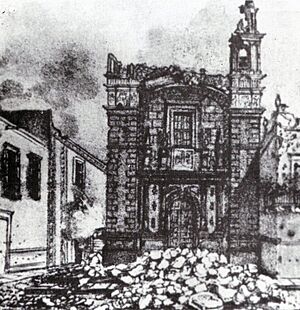
A revolt also started in Puebla on December 12. General Guitian joined a revolt in Zacapoaxtla against the Juárez Law. Other military leaders joined the rebels, including Miguel Miramón. More conservative revolts followed in other states like Oaxaca and Jalisco.
Comonfort suspected some people were causing trouble and ordered them to leave the country. One of them, Antonio de Haro, escaped and joined the rebels. The rebels then attacked Puebla on January 16, 1855, and the governor surrendered. The revolution grew strong, with 4,000 men and good supplies.
Comonfort decided to lead the troops himself. On February 29, he set off with 11,500 men. The rebels retreated inside Puebla's walls. On March 8, the rebels tried to break out, but after a long fight, they asked for a truce. Comonfort began a siege of Puebla on March 9, which lasted until March 22, when the rebels surrendered.
The government then ordered the seizure of Church properties in Puebla and Veracruz. These properties, except those used for worship, were to be sold to pay for damages from the rebellion.
The New Constitution
The special congress, called by Álvarez, met on February 14. On February 21, they officially approved Comonfort as president. The congress was very progressive, like a similar one in 1833. They began working on a new constitution.
The congress approved the Juárez Law and canceled many appointments made by Santa Anna. On May 12, the Bishop of Puebla was sent out of Mexico for resisting the seizure of Church properties. On June 5, the congress voted to expel the Jesuits from the country. Critics said this went against the idea of religious freedom.
Mexico also faced money problems. Santa Anna's taxes had been removed, and there wasn't enough income. The government tried to boost the economy by opening ports for trade and encouraging business. Foreigners were allowed to own land under certain rules.
The new constitution's first draft was read on June 16. It included many ideas from the Constitution of the United States. It also had a "Declaration of the Rights of Man," which included ideas from other advanced nations. Equality before the law was a basic right.
Comonfort faced challenges from both the radical liberals and the conservative Church supporters. Both groups accused him of giving too much to the other side.
Ley Lerdo and Land Reform
In June 1856, another big issue arose with the Ley Lerdo. This law was named after the Minister of the Treasury. It aimed to end collective ownership of land. It forced "civil or Church institutions" to sell any land they owned. People already living on the land had the first chance to buy it.
This law mainly targeted the Church, but it also affected Mexico's native communities. It forced them to sell their shared lands, called ejidos.
On July 1, the Archbishop protested the law. He argued that the land would likely be bought by a few rich people. He also said the Church had been fair to its tenants. The government did not change its policy. The law was meant to help Mexico's economy by increasing private land ownership. However, in reality, rich people bought most of the land, and many native lands ended up as large private estates (haciendas).
The New Constitution is Adopted
The new constitution continued to be written despite opposition from conservative newspapers. Many in Congress wanted to bring back the old Constitution of 1824. However, the congress as a whole approved the new constitution by a large vote (93 to 5).
A debate about religious freedom took place from July 29 to August 5. In the end, religious freedom was not explicitly put into the constitution. But it also didn't say Mexico was a Catholic-only state, which meant there was a kind of religious freedom in practice.
The constitutional congress finished its work on February 5, 1857. The new constitution was signed, and President Comonfort promised to follow it. On February 12, Comonfort officially announced the new constitution. It was set to become law on September 16. However, before the year ended, Comonfort himself would reject it, and a civil war would begin.
Oath to the Constitution
On March 17, 1857, a law was passed requiring all public workers to publicly swear an oath to the new constitution. The Catholic Church declared that anyone who took this oath would be excommunicated (removed from the Church). As a result, many Catholics in government lost their jobs because they refused the oath.
Newspapers reported on who refused the oath, including judges and other federal workers. Many local officials also refused. Some even took back their oaths so they could receive religious services during Lent.
Liberal officials fought back against this opposition. The governor of Oaxaca, Juárez, expelled priests who refused to give Christian burials to supporters of the constitution. Other governors also took action against those who refused the oath.
Leading to the Reform War
The clergy in Puebla were determined to stop the Lerdo Law. The government responded with strong measures. Church property sales continued slowly. The government also sent military officers and Church leaders charged with causing trouble out of the country. On September 15, many Franciscans were arrested, and their convent was taken over by troops. The government then ordered the convent closed and its property seized.
In early October, the government sent a representative to Rome to try and get the Pope to agree to the constitution. The government also asked the Archbishop to control clergy who were encouraging people to disobey the government.
Comonfort also had to deal with a revolt by Governor Santiago Vidaurri in Nuevo León in the north. Almost all of Mexico's available troops had to be sent north to deal with this uprising.
On October 13, conservative officer Tomas Mejia took control of Querétaro City. The rebels promised to protect the land of native people, which was also affected by the Lerdo Law.
Another revolt broke out in Puebla City on October 20. Colonel Joaquin Orihuela and Lieutenant Colonel Miguel Miramón, led by Father Francisco Javier Miranda, seized weapons and arrested the governor. They demanded an end to the Juárez and Lerdo Laws.
These revolts united Congress behind Comonfort. They gave him emergency powers to deal with the uprisings. Forces were sent to Puebla, and the besieged conservatives finally surrendered on November 29. Miramón managed to escape.
Comonfort faced a difficult choice: fully support the new constitution's reforms or try to find a middle ground. The opposition press began to suggest that Comonfort should continue ruling with special powers instead of letting the constitution take full effect.
On September 15, Comonfort's entire cabinet resigned. His emergency powers had ended, and the new Congress was not yet meeting. The country was full of rebellions. Businesses in the capital closed, and troops patrolled the streets.
Congress met on October 8. Comonfort asked for emergency powers to deal with the rebellions. Congress refused at first. However, on November 3, they suspended certain parts of the constitution that limited Comonfort's ability to stop the rebellions. These included rules on freedom of speech, assembly, and gun ownership.
Comonfort officially became president on December 1, 1857, after winning the presidential elections. In his speech, he asked representatives to change the constitution, saying he had always supported liberal causes.
The Plan of Tacubaya
Conservative leaders began to gather support for a plan to get rid of Congress and give Comonfort emergency powers again. Some of Comonfort's own government members were accused of plotting against the constitution.
On December 17, a plan called the Plan of Tacubaya was announced. It aimed to set aside the national constitution. It said that Ignacio Comonfort would be in charge of the government. He would then call a new congress within three months to write a new constitution that would be more in line with what the country wanted.
On December 17, Congress protested against the Plan of Tacubaya and declared that Comonfort's power had ended. However, a military brigade led by Felix Zuloaga occupied the capital and dissolved Congress. Benito Juárez, who was the head of the Supreme Court, was arrested.
On December 19, Comonfort officially announced that he had accepted the Plan of Tacubaya. He explained that he saw it as a way to find a moderate solution and avoid chaos.
However, the state of Vera Cruz abandoned the Plan of Tacubaya on December 30. This made Comonfort realize his new government was in trouble.
Comonfort's Resignation
Comonfort now wanted to distance himself from the government he had helped create. He told his troops that he regretted supporting the Plan of Tacubaya. He even thought about joining the troops fighting against the conservatives. His council advised him to completely withdraw from the plan.
On January 11, more troops near the capital joined the Plan of Tacubaya. Comonfort decided to go with 5,000 loyal troops to the constitutionalists' headquarters. He intended to step down and hand over the presidency to his legal successor, Benito Juárez, who was the head of the Supreme Court. Comonfort released Juárez from prison. Juárez then went to Guanajuato and set up a new government on January 19.
Exile, Return, and Death
After being advised that fighting in the capital was useless, Comonfort left Mexico City on January 22. He went to the liberal-controlled state of Vera Cruz. On February 7, he left for Europe with his family.
In 1861, Comonfort was living in Texas. He asked for permission to return to Mexico. The government at first ordered his arrest but then accepted his help when the French invasion began.
Comonfort had to lead newly recruited troops who were not ready to fight the French. He was defeated on May 8, 1863, at the Battle of San Lorenzo and retreated to Mexico City. When the Mexican government left the capital on May 31, 1863, Comonfort went with them and was even made Minister of War.
On November 13, Comonfort was traveling from San Luis Potosí to Guanajuato. He was killed in a surprise attack near Celaya by a group led by Chief Gonzales Aguirre. His body was taken to San Miguel de Allende. After the Mexican Republic was restored in 1867, his ashes were moved to the San Fernando cemetery.
See also
 In Spanish: Ignacio Comonfort para niños
In Spanish: Ignacio Comonfort para niños
- List of heads of state of Mexico
- Liberalism in Mexico


